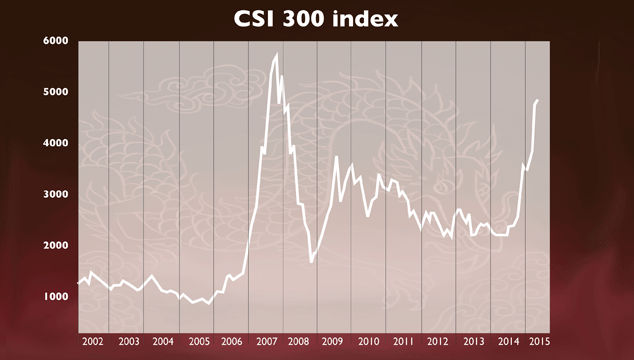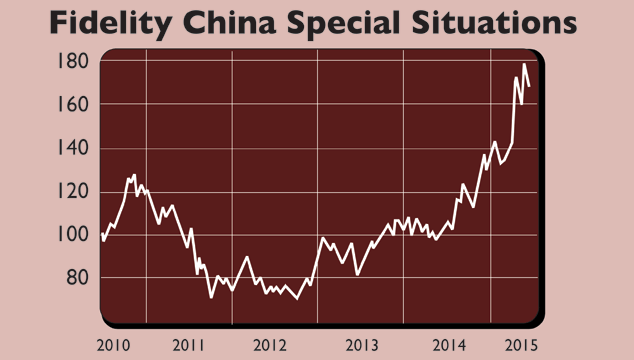Get ready to buy Chinese stocks
The recent rally in Chinese stocks has raised fears of a bubble – but this is a bull market that’s only just beginning, says Rupert Foster.


"Colour Me Impressed," as The Replacements, those great icons of 1980s alternative rock, sang. Most investors around the world are green with envy at the 140% and 180% rise respectively in China's Shanghai and Shenzhen stockmarkets over the past year. Having missed out, the majority of investors are now describing it as a ridiculous bubble that no sensible person could ever have got involved with in the first place.
That view is reinforced by the spectacular performance of recent initial public offerings (IPOs), such as Beijing Baofeng Technology (market cap $5bn), which listed in March and is up more than 4,000% so far. So it might seem unhinged to argue that the bull market in Chinese equities has only just started but that's what I will do.
Not a promising backdrop
However, before we get into the reasons to be bullish, let's have a quick recap of the economic backdrop to this massive market move. It's fair to say that the state of the Chinese economy doesn't offer obvious reasons to be bullish. GDP growth has been slowing since 2010 and the slide has accelerated in the last year.
MoneyWeek
Subscribe to MoneyWeek today and get your first six magazine issues absolutely FREE

Sign up to Money Morning
Don't miss the latest investment and personal finances news, market analysis, plus money-saving tips with our free twice-daily newsletter
Don't miss the latest investment and personal finances news, market analysis, plus money-saving tips with our free twice-daily newsletter
The government will get close to its 7% target this year, but "actual" GDP growth feels more like 3%-4%, far removed from the heady days of the 2000s when growth was regularly in double figures. Meanwhile, despite the slowing economy, credit growth continues at 19.5% per year. As a result, China's debt to GDP ratio continues to rise worryingly, to 218% this year.
The real estate market is weak: the backlog of unsold new properties in Tier 2 and Tier 3 cities continue to run near all-time highs of 22 months (in China, second and third-tier cities are large cities beyond the four biggest and richest, which are Beijing, Guangzhou, Shanghai and Shenzhen). And while the fact that wages continue to rise at 5%-10% per year may sound like good news for consumer demand, it reflects China's looming demographic problem: as the population ages, fewer young people are coming into the workforce.
Against this backdrop, the rally in the market which began in early 2014 may seem hard to explain. Initially, the rationale for the move was high net-worth investors in China moving into the market after losing interest in property investment and private equity (the latter traditionally being the two main investment areas for rich Chinese who cannot move their money out of the country).
So it was generally ignored by foreign investors. The government then started loosening monetary policy and stockmarket liquidity and also surprised investors with the announcement of the Shanghai/Hong Kong Connect in September, which was a step towards opening up China's markets to foreign investors (see below).
Then the real liquidity started flowing into the market as day traders got involved, and a big move up in November 2014 started to attract foreign investors. Most pundits predicted an early fall back this year, yet the China A share market is up a further 50% this year helped by growing excitement from Chinese investors about the planned inclusion of the Shenzhen market within the Hong Kong Connect scheme.
A correction may be coming
All this has pushed the Chinese A share market to some pretty steep valuations (the CSI 300 index trades on a price/earnings, or p/e, ratio of 22.5). Even a committed long-term bull on China will be uncomfortable about buying the market at such steep valuations, especially given the euphoric mood.
What's more, the market is approaching the level it reached at the peak of its last bull market in 2007, meaning that it looks vulnerable to a correction which could easily be sparked by the government's recent efforts to curb the ability of day traders to trade on margin (speculate with borrowed money). After such a large, rapid rise, a 30% correction in mainland shares would be a conservative estimate. Hong Kong and US-listed China shares would probably fall by a smaller but still significant amount.

However, this correction will be temporary and will offer a second opportunity to get into Chinese equities. The second phase of the boom will then kick off, and this is likely to see Chinese equities listed in Hong Kong and the US taking part more aggressively in the rally.
So what's the rationale for a continued bull run? It all hinges on where China stands in its development cycle. To understand this better, we need to look at the other two leading North Asian economies, Japan and South Korea, and their experience of development. Japan was the first North Asia country to develop by following the "Control" economy model. This saw one political party dominate politics and exert strong control over the economy, directing efforts into a few key sectors.
South Korea and Taiwan then followed this model slavishly and largely successfully. China hasfollowed the same path.So studying how economies and markets performed in these countries provides some insight into what we can expect from China in the years ahead.
Each country has had a hyper-growth phase, where GDP growth exceeded 8% per year for a decade or so. Their first stockmarket bubble came near the end of this hyper-growth phase: Japan 1967-1972, 400% rise in the stockmarket; Korea 1985-1988, +500%; and China 2006-2007, +600%.
Each then had a noticeable correction and the key for recovery from this correction was a government-directed shift in the make-up of the economy. These economies were all investment-led in their first phase, as the government printed cheap money and channeled it into infrastructure and heavy industrial sectors, such as steel, shipbuilding, chemicals, cars and electricals.
In the second phase, they need to be consumption-led. Japan and Korea successfully shifted their economies, meaning that the percentage of GDP arising from consumption started to rise. This led to a rise in optimism among investors and the Japanese and Korean stockmarkets returned to their highs within six years of the bursting of the initial bubble. China has taken a little longer it's now eight years on from its 2007 peak but the gains in the last 12 months have retraced almost all of the losses in 2007-2009.
China needs to boost consumption
The Chinese recovery has been slower in part because China has still not seen consumption rising as a share of GDP. But all indicators point to this starting to happen in the second half of this year. Why is this? Chinese consumers remain cautious saving more of their income than their Japanese and Korean counterparts. With no social safety net and a weak legal system, consumers have strong incentives to save. However, the most striking difference with Japan and Korea at this stage of their development, is China's low level of urbanisation.
This may sound contrary to most Western commentary, which has focused on the growth in Chinese cities. But China has 20 percentage points more of population still involved in agriculture than Japan and Korea did at this stage in their development. This makes a big difference to consumption, because farmers earn and spend a third of what city dwellers do.
Having 300 million more people move from agriculture to urban life and consuming more would alter the whole make-up of Chinese GDP. The government understands this, so many of its policies are focused on encouraging urbanisation. This will drive Chinese consumption, and so will push its stockmarket higher.
An indication of the importance that the Chinese government has put on accelerating consumption was the announcement last month of a raft of measures to reduce import taxes and luxury taxes. Imported products in China have until now suffered punitive taxes of up to 50%. This has encouraged Chinese retail tourism with the main beneficiaries being Hong Kong, Macau, Seoul, Tokyo and various Western capitals.
Indeed, a trip could be paid for by purchasing a couple of Rolexes or a Prada handbag and selling them to back in China at a higher price. However, it has also discouraged domestic consumption. Hence while the government is still in the midst of an anti-corruption drive that is clamping down on luxury spending by officials, it is set to sweep away many of these taxes in the next couple of years.
Get ready for a consumer-stock boom
The advent of a proper Chinese consumer-led economy will lead the stockmarket to focus on domestic Chinese consumer franchises and also those that have the potential to globalise. In Japan, the equivalent period was the late seventies to mid-eighties, when the view of Japanese manufacturing as "Jap-Crap" morphed into cool consumer brands supplied by Sony, Pioneer and Nintendo and the Japanese car brands built their name for cheap, reliable cars that destroyed the faulty rustbuckets being churned out by Ford and GM.
So which Chinese brands will benefit and perhaps go global? Consumer electronics is not the business it once was. The focus is now around the smartphone. Apple holds its own in China, but Samsung, along with all the other non-Chinese companies, is steadily losing share to Chinese players, with unlisted Xiaomi and Oppo looking the most likely to take the fight to the larger world.
Meanwhile, the Chinese car industry is hamstrung by its focus on joint ventures with foreign players, who have limited technical know-how and poor local branding. But there are three large independent Chinese car companies (Great Wall, Geely and unlisted Chery) and it would seem likely that at least two of these will break into the global market. Great Wall's technical capabilities and Geely's purchase of Volvo in 2010 make them the most likely.
But, ironically for a country that controls the supposedly free internet with such verve, it is e-business in whichChina looks most likely to succeed.The internet is revolutionising a vast swathe of industries in China, as it is around the world. However, in most sectors of Western countries there are strong existing businesses, often formed into oligopolies and thus controlling supply chains and distribution.
Good examples are financial servicesor cable and satellite television.These legacy businesses delay the introduction of new business models.In China these legacy business may not have existed at all, or were in a much weaker state. So the new internet-based players can take share much quicker.
For example, until last year China's banking system was a government monopoly, operating through thousands of central and local government-owned banks. When online giant Alibaba opened an internet-based money market fund product called Yu'E Bao last year, it took in $90bn in a few months. The government had to step in to introduce new regulations on internet finance, after screams of protest from the main banks, who feared a vast outflow of deposits.
Other Chinese internet businesses are growing at a rapid pace. E-commerce firms such as Alibaba and JD.com are leading the way, but other smaller businesses are attracting just as much attention: travel (Ctrip/Qunar), estate agency (Soufun/Ehouse), education (TAL, Tarena), car dealing (Bitauto/Autohome). Once these businesses have grown large and dominant in their local market, they will turn to overseas expansion taking the immense economies of scale garnered in the world's most populous country to undercut competition.
You'll note from the above that all China's best internet businesses are listed in the US or Hong Kong. This is one of the reasons to expect Chinese stocks listed outside China to participate more fully in the next stage of the bull market. Since the creation of the Shanghai/Hong Kong Connect, Chinese domestic investors have been allowed to invest directly in the Hong Kong stockmarket.
They have only started doing this recently and the Southward (China into Hong Kong) daily quota is still not being used up so we are still in the early phase of the movement of money into Hong Kong. Yet it's here that the consumer stocks that investors will really want are listed and they are priced to attract buyers.
When you are paying 300 times earnings for a second-rate tech business listed in Shenzhen and the far superior Tencent trades on only 35 times earnings in Hong Kong, an increase in flows into Hong Kong appears inevitable. Like Japan in the 1980s, the next few years may lead to extreme valuations for Chinese equities becoming the norm. In the end, markets will have to correct to sensible valuations but these anomalies can last for years.
What could stop the bull?
There are obviously risks to this scenario. Most foreign investors would point to the Chinese debt mountain and the wobbly property market as reasons to be nervous. Chinese debt is undoubtedly high and the pace at which it is rising further remains worrying. But the key feature of Chinese debt is that it is mostly domestic (Chinese banks lending to Chinese entities in renminbi). What's more, 70% of it represents lending by government-owned banks to government-owned entities state-owned enterprises (SOEs) or local and municipal governments.
SOEs were incredibly profligate between 2009 and 2013, and the government is now trying to reform them, but it's important to see that this debt mountain is under the control of the government and it's up to them what happens to it. There is also around $200bn of foreign corporate debt, which is a risk but not a catalyst for collapse, given that the central government holds foreign currency reserves totalling $2trn.
Meanwhile, the property market may be starting to perk up after a couple of weak years. Loosening measures announced by the government over the last year particularly a reduction in second home mortgage down payment from 60% to 40% announced in April are having an effect: volumes are picking up and pricing is stabilising. It's worth remembering that levels of mortgage debt in China's residential property market are low (buyers typically put in plenty of cash).
In addition, the average annual price increase over the last ten years has been noticeably less than wage growth, so affordability is steadily improving. If you compare it to the UK property market with a huge debt burden and a government puffing up demand Chinese observers feel it is obvious who is likely to have a crash!
So my greatest concern about China is rather different to the consensus it's that they do not clean up their legal system fast enough. Currently, foreign owners of domestic assets have no certainty that they can take control of those assets if the Chinese management resist. This has held back many conservative Western investors and is certainly a strong reason to be spread your risks when investing in China. That, it's clearly not in China's best interests to allow its weak legal system to continue and I believe they will address this. But it will require strong leadership to break down the ossification of the Chinese Communist Party and tackle vested interests.
So investors may want to lock in profits from China's gains so far soon. But they should spend the summer researching their favourite Chinese brands in advance of the next leg up. The Chinese bull market, which took rein in the year of the horse, is still likely to be bringing home the bacon as the year of the pig dawns.
How to buy into the A-share boom

Chinese shares can be dividend into two very broad groups A shares, listed in mainland China itself, and those listed on exchanges outside China, such as Hong Kong, Singapore, the US and even the London Stock Exchange, writes Matthew Partridge. The latter are often referred as H shares, S chips, N shares and so on. Since there are restrictions on foreign investors buying A shares and Chinese investors buying foreign stocks, the two groups often behave very differently. So when we talk about the recent bull market in Chinese stocks, we are mostly referring to A shares although many shares outside the mainland have also posted gains.
This means that when you consider investing in China, you need first to be clear which group of shares you want to buy and check that the fund you plan to buy is exposed to them. Many China funds have no or little exposure to A shares in some cases because of the restrictions on accessing them, but also because many managers still consider the A share market to be difficult to invest in due to poor transparency or low corporate governance standards.
The easiest way to buy into the A share market is through a exchange-traded fund (ETF). There are now a growing number of these listed on the London stock exchange, such as the MSCI China A GO UCITS ETF (LSE: CASH), which tracks the MSCI China A Index, or the db x-trackers Harvest CSI 300 China A-Shares ETF (LSE: ASHR). Both track a basket of larger stocks listed on the Shanghai and Shenzhen exchanges in Shanghai and Schenzen.
These ETFs are relatively expensive for passive funds, with ongoing charges of 0.88% and 0.80% per year respectively, but both have the benefit of physically holding the shares unlike some ETFs that use derivatives to gain exposure. This means that charges should be more transparent. Ongoing deregulation of the A share market to open it to more investors should spur more competition and put further downward pressure onfund costs.
Actively managed funds have also been taking advantage of the opportunities provided by the current liberalisation.When Fidelity China Special Situations (LSE: FCSS) launched in 2010, we were highly critical of the fund, anticipating that star manager Anthony Bolton would be unable to replicate his previous success in the UK market.

However, since he stepped down last summer, the fund has performed much better under its new manager, Dave Nicholls. Just under a third of the funds holdings are now in A-shares, and Nicholls plans to expand this even further. The fund has a annual management charge of just 1%, though a performance related fee and other costs have pushed this up to an annual expense ratio of 1.46%.
If you're not concerned about investing specifically in A shares, but simply want a good fund that gives you exposure to China's growth and development, one candidate is First State Greater China Growth Fund. This fund, managed by the highly regarded Martin Lau, invests in companies in Hong Kong and Taiwan as well as those from mainland China.
Buying A shares
Until relatively recently, Chinaimposed tough restrictions on foreigninvestment in A shares listed on themainland Shanghai and Shenzhenstockmarkets. A small number offoreign institutions were grantedqualified foreign institutional investors(QFII) quotas, allowing them to invest alimited amount, but the market was offlimits to individual investors. There is aparallel "B share" market in Shanghaiand Shenzhen, open to all foreigninvestors, but few firms botheredto list B shares and so this market islargely moribund.
However, recent efforts at liberalisingChina's stockmarkets have finallyoffered retail investors a limitedlevel of direct access to the Chinesemarket. The Shanghai-Hong KongConnect, which launched in November2014, allows overseas investors totrade many Shanghai-listed A sharesthrough a link between the Shanghaiand Hong Kong stock exchanges(stocks listed in Shenzhen are notcurrently included but are expected tobe added later this year).
The link is atwo-way system, so mainland Chineseinvestors are also able to purchaseHong Kong shares through an onshoreaccount for the first time. There is astrict cap on the amount of shares thatcan be bought via these methods, soit is very far from a free for all (andthe daily limit on flows into China isconsistently reached). However, thegood news is that the limits are on netpurchases, so you will always be ableto sell any shares that you buy.
If you are considering investingdirectly in individual A shares, youshould note that the market is highlyvolatile and corporate governancestandards in mainland China areweak, so this is definitely a high-riskmarket suitable only for experiencedand adventurous investors. Becauseit remains a niche interest amongindividual investors, few UK brokersoffer access to Connect.
Onepossibility is Interactive Brokers, which isa US firm with a UK-regulated arm.Another option is to open an accountwith a Hong Kong-based brokerage,such as Boom Securities,which is owned by Japan's MonexGroup.
Get the latest financial news, insights and expert analysis from our award-winning MoneyWeek team, to help you understand what really matters when it comes to your finances.
Rupert is an investment strategist and adviser at J & C Foster, providing Asian, Consumer and Global Equities Strategy advice to a number of family offices and portfolio management organisations. He writes on Asia and Global Macroeconomics for a number of investment publications including MoneyWeek and HL Investment Times.
-
 Why Trustpilot is a stock to watch for e-commerce exposure
Why Trustpilot is a stock to watch for e-commerce exposureTrustpilot has built a defensible position in one of the most critical areas of the internet: the infrastructure of trust, says Jamie Ward
-
 Tetragon Financial: An investment trust with stellar returns
Tetragon Financial: An investment trust with stellar returnsTetragon Financial has performed very well, but it won't appeal to most investors – there are clear reasons for the huge discount, says Rupert Hargreaves
